Are you freezing in the winter? Do you think it's too cold around you? Do you feel tears in your eyes when you think about the warm sun? There are places that are much, much colder, and yet somehow people exist there. How exactly do they live - in our top 10 coldest cities in the world. Winter temperature records are given for all cities.
10. Harbin, China - minus 38.1°C
 For the residents of this city, even the harsh winter is a pleasure. After all, thanks to it, the International Snow and Ice Festival is held in Harbin. This is one of the largest ice festivals in the world. Ice sculptures are demonstrated there, swimming in a winter ice hole is organized, and alpine skiing is held.
For the residents of this city, even the harsh winter is a pleasure. After all, thanks to it, the International Snow and Ice Festival is held in Harbin. This is one of the largest ice festivals in the world. Ice sculptures are demonstrated there, swimming in a winter ice hole is organized, and alpine skiing is held.
9. Longyearbyen, Norway - minus 46.3°C
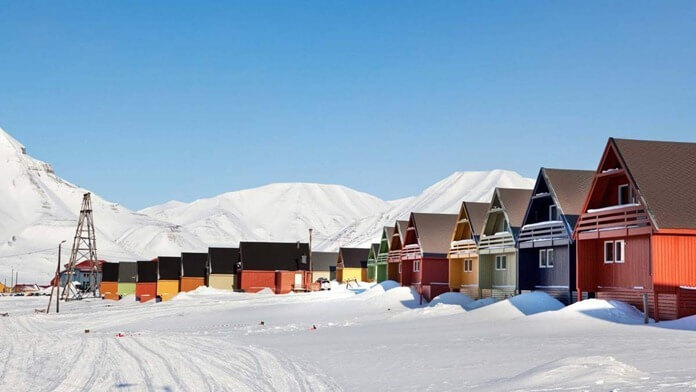 This settlement, located on the island of West Spitsbergen, has one of the strangest prohibitions in the world. You can't be born or die here. That's why there is no maternity hospital or cemetery here. And the bodies of the dead are transported to the mainland. Longyearbyen is also famous for the fact that the UN insisted on building an underground Global Seed Vault here. It will come in handy in the event of a global catastrophe.
This settlement, located on the island of West Spitsbergen, has one of the strangest prohibitions in the world. You can't be born or die here. That's why there is no maternity hospital or cemetery here. And the bodies of the dead are transported to the mainland. Longyearbyen is also famous for the fact that the UN insisted on building an underground Global Seed Vault here. It will come in handy in the event of a global catastrophe.
8. Barrow, USA - minus 47°C
 Cold weather comes unexpectedly to this American city (almost like to Russian utilities). Just yesterday people were driving their cars, and today they have to use snow removal equipment. Such temperature differences make living in Barrow quite difficult. However, this is what homo sapiens is famous for: he can adapt to almost any conditions.
Cold weather comes unexpectedly to this American city (almost like to Russian utilities). Just yesterday people were driving their cars, and today they have to use snow removal equipment. Such temperature differences make living in Barrow quite difficult. However, this is what homo sapiens is famous for: he can adapt to almost any conditions.
7. Winnipeg, Canada - minus 47.8°C
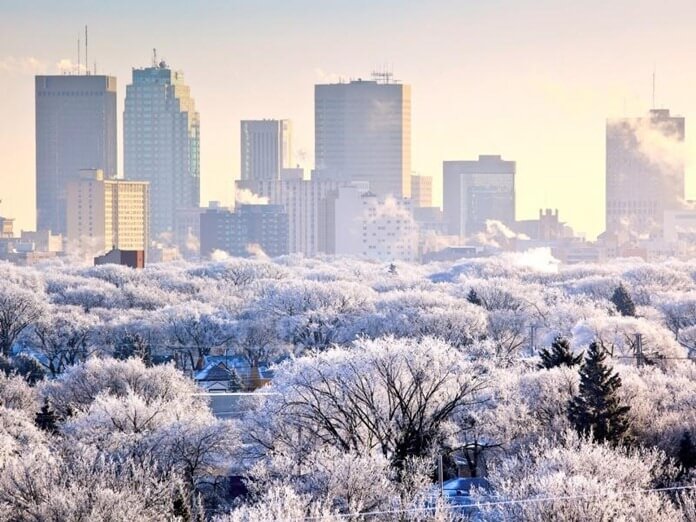 One of the coldest places on the planet is the capital of the Canadian province of Manitoba. Normal January lows there range from minus 20 to minus 22°C. And on December 24, 1879, the city's temperature record was set at minus 47.8°C. It must have been an unpleasant day for the city's residents.
One of the coldest places on the planet is the capital of the Canadian province of Manitoba. Normal January lows there range from minus 20 to minus 22°C. And on December 24, 1879, the city's temperature record was set at minus 47.8°C. It must have been an unpleasant day for the city's residents.
6. Yellowknife, Canada - minus 51°C
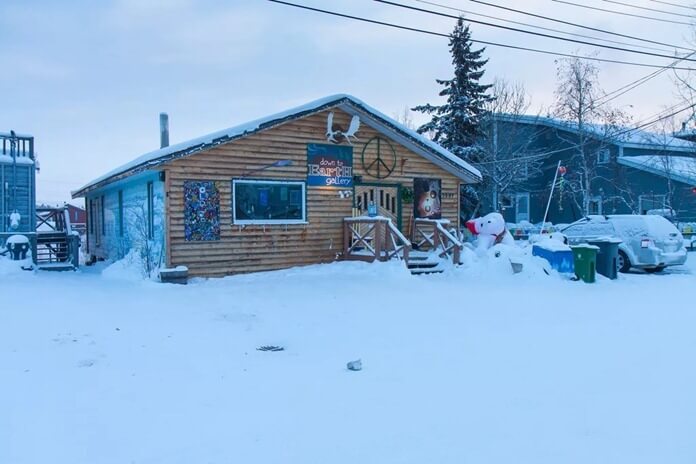 Founded in 1934, Yellowknife is the capital of Canada's Northwest Territories. It is home to over 20,000 people, most of whom are employed in the mining industry. The city boasts long, clear winter nights that provide optimal conditions for viewing the northern lights from mid-November to early April.
Founded in 1934, Yellowknife is the capital of Canada's Northwest Territories. It is home to over 20,000 people, most of whom are employed in the mining industry. The city boasts long, clear winter nights that provide optimal conditions for viewing the northern lights from mid-November to early April.
5. Dudinka, Russia - minus 61°C
 One of the world's northernmost cities regularly faces extreme winter conditions, with average daily lows in January at minus 33 degrees Celsius.
One of the world's northernmost cities regularly faces extreme winter conditions, with average daily lows in January at minus 33 degrees Celsius.
This city is home to the world's only ice stadium beyond the Arctic Circle - the Taimyr Ice Arena.
4. Norilsk, Russia - minus 64°C
 Norilsk has never had a mild climate. In winter, it often reaches minus 40 degrees. However, in 2014, a new temperature minimum was recorded there - 64°C below zero. Interestingly, Norilsk and Murmansk are located at almost the same latitude. However, it is noticeably warmer in Murmansk.
Norilsk has never had a mild climate. In winter, it often reaches minus 40 degrees. However, in 2014, a new temperature minimum was recorded there - 64°C below zero. Interestingly, Norilsk and Murmansk are located at almost the same latitude. However, it is noticeably warmer in Murmansk.
3. Yakutsk, Russia - minus 64.4°C
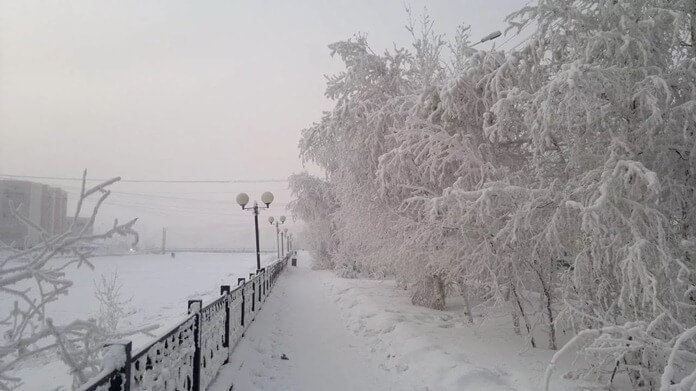 The capital of the Sakha Republic opens the top three coldest cities on Earth. It is famous for its very harsh winter conditions. The most extreme temperatures occur in January, with average temperatures ranging from minus 38°C to minus 41°C. In 1891, a temperature record with a minus sign was recorded (64°C below zero).
The capital of the Sakha Republic opens the top three coldest cities on Earth. It is famous for its very harsh winter conditions. The most extreme temperatures occur in January, with average temperatures ranging from minus 38°C to minus 41°C. In 1891, a temperature record with a minus sign was recorded (64°C below zero).
In addition, the winter season in Yakutsk can begin much earlier than in other cities of the world.
2. Verkhoyansk, Russia - minus 67.7°C
 Technically, this city can be considered the coldest on Earth, since the leader of our list is a village. There are not many residents in Verkhoyansk - 1131 people as of 2017. And this is understandable, there are few who want to live in a place that bears the title of "Pole of Cold in the Northern Hemisphere".
Technically, this city can be considered the coldest on Earth, since the leader of our list is a village. There are not many residents in Verkhoyansk - 1131 people as of 2017. And this is understandable, there are few who want to live in a place that bears the title of "Pole of Cold in the Northern Hemisphere".
1. Oymyakon, Russia - minus 71.2°C
 Here is the answer to the question of which place is the coldest on Earth. The average winter temperature in the village of Oymyakon is minus 50°C. And the lowest recorded temperature is a mind-boggling -71.2 degrees. True, it is almost a century away from our time; it was measured in 1924. For comparison: in the hottest place in the world, the air warms up to 70 degrees.
Here is the answer to the question of which place is the coldest on Earth. The average winter temperature in the village of Oymyakon is minus 50°C. And the lowest recorded temperature is a mind-boggling -71.2 degrees. True, it is almost a century away from our time; it was measured in 1924. For comparison: in the hottest place in the world, the air warms up to 70 degrees.
Why is Oymyakon the coldest city in the world?
The reason is the geographical location of the village, which is unlucky for several reasons. It is located in a river valley surrounded by mountains that form something like a horseshoe. The open top of the arc points north. At night, dense and heavy cold air flows down from the mountains and accumulates in the depression where the village is located.
The altitude also plays a role: as a rule, the higher the place, the colder it is. Summer in the village is short, only three months, but hot, with large temperature differences; if during the day it can be plus 30°C, then at night the air cools down to minus.
The irony is in the name "Oymyakon" itself. It comes from an Evenki word meaning a non-freezing spring, or a place where fish spend the winter. There really is a spring near the village, which is probably why locals began to settle here. They quickly got used to the low temperatures.

A temperature of -40°C is considered cold, but not too cold. -25°C is unusually warm. The fact that the weather is usually windless also helps to adapt to the cold – it is easier to bear the cold. Locals even say that they prefer to live here rather than in places where winters are more moderate, but windy and damp. They measure the temperature with special thermometers with a mercury-thallium alloy so that the mercury does not freeze. The maximum minimum temperature there is -61.1°C.
At such temperatures, the simplest actions like taking a child to kindergarten or school, going to the store turn into a whole quest. Usually, residents of Oymyakon during the "winter" months try to go outside as little as possible - only to the store for groceries, quickly, wrapped in a scarf and additionally pressing a mitten to the face.
But residents of Yakutsk, located two days away by car, have to call a taxi or travel only by private transport. By the way, the frosts are not an excuse for Oymyakon children to miss school - it works up to -52°C.
What clothes protect you from the frost in Oymyakon
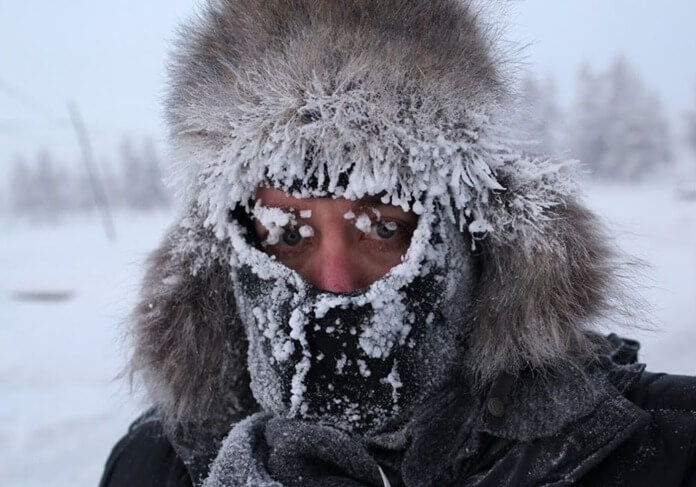 Locals dress in furs, of course – the more natural and thicker, the better. Fur hats, fur boots (made of reindeer skin and fur), mittens, and a scarf covering the entire face to protect the skin from burns. Faux fur is absolutely no good. It quickly becomes unusable in the cold, and sometimes literally breaks.
Locals dress in furs, of course – the more natural and thicker, the better. Fur hats, fur boots (made of reindeer skin and fur), mittens, and a scarf covering the entire face to protect the skin from burns. Faux fur is absolutely no good. It quickly becomes unusable in the cold, and sometimes literally breaks.
Children are bundled up to such an extent that they are practically unable to move independently when going to kindergarten - only their eyebrows and eyes are visible. Therefore, parents take them on sleds, and the fur blanket that is laid on these sleds is warmed up beforehand.
Nutrition
 It is impossible to grow crops in permafrost conditions, so the locals mainly eat dense protein foods. Stroganina has firmly established itself on the menu, as it has for centuries, among the indigenous peoples of the North. This is shavings from a frozen piece of meat or fish. And the daily menu most often consists of thick soup with the same meat or fish. In such a climate, local residents do not need refrigerators, because everything is stored right outside the window.
It is impossible to grow crops in permafrost conditions, so the locals mainly eat dense protein foods. Stroganina has firmly established itself on the menu, as it has for centuries, among the indigenous peoples of the North. This is shavings from a frozen piece of meat or fish. And the daily menu most often consists of thick soup with the same meat or fish. In such a climate, local residents do not need refrigerators, because everything is stored right outside the window.
Pets
 The residents of Oymyakon keep cattle, but in such cold weather they try not to let them out on the street. In winter, only the hardy Yakut horses (they are covered with long thick wool) and dogs are let out on the street. Cows see the white winter light only in case of extreme necessity, and even then their udders are specially wrapped to prevent frostbite.
The residents of Oymyakon keep cattle, but in such cold weather they try not to let them out on the street. In winter, only the hardy Yakut horses (they are covered with long thick wool) and dogs are let out on the street. Cows see the white winter light only in case of extreme necessity, and even then their udders are specially wrapped to prevent frostbite.
Public utilities
Permafrost, extremely low temperatures and sewage systems are incompatible, so most toilets in Oymyakon are outside the houses. Oymyakon gets its heat from a local coal-fired heating station. Its condition, like that of the central heating in the city of Yakutsk, located two days away, is checked as early as June. Pipes are replaced if necessary.
Power outages are the worst thing that can happen in the Far North. If this happens, all the Oymyakon residents go out into the streets and try to warm up the most necessary buildings for the village - the kindergarten, the only store, the canteen - with burners. The pipes had to be dug out and warmed manually to prevent them from freezing. Fortunately, this does not happen often.
Transport
 There are two ways to get from Yakutsk to Oymyakon – either by car or by air. Airplanes fly only in the warmest time of the year, in summer, and no more than once a week. Therefore, the main connection with the world is carried out by automobile transport. The most durable is considered to be the classic UAZ-loaf, capable of overcoming more than a thousand kilometers of ice- and snow-covered highway without any special consequences for itself.
There are two ways to get from Yakutsk to Oymyakon – either by car or by air. Airplanes fly only in the warmest time of the year, in summer, and no more than once a week. Therefore, the main connection with the world is carried out by automobile transport. The most durable is considered to be the classic UAZ-loaf, capable of overcoming more than a thousand kilometers of ice- and snow-covered highway without any special consequences for itself.
Cars in the Far North require special, careful handling. Drivers often put a woolen blanket on the hood and another one under it to "warm" the engine and electrics. Cars in the north have double windows to prevent them from becoming covered with ice. If the car is outside, it must be kept idling. It can only be stopped in a heated garage. If the engine is stopped in the open air, the battery will freeze instantly, and it will be impossible to start the car. Therefore, if the engine suddenly stalls somewhere outside the city, you have to defrost the battery over a fire and, in addition, heat the metal casing under the engine.
Long-distance carriers do not turn off the engines of their iron horses for months at a time. Due to the harsh northern conditions, the vast majority of gas stations in the Yakutsk region operate 24 hours a day.
The constantly running engines of cars, the breath of people and the steam from working industrial enterprises create a dense curtain that covers Yakutsk in the coldest time of the year. Sometimes it is so thick that nothing can be seen at a distance of ten steps.
Gadgets
It is better not to take small electronics outside in the Far North, because they instantly turn into a piece of ice. Therefore, owners keep them in their inside pockets, warming them with their own body heat, and take them out only in heated rooms. Taking photos at such subzero temperatures is very difficult.
Diseases and death
 Surprisingly, there are no colds in such extreme colds. Viruses and bacteria simply freeze. It is easy to freeze something, but not to catch a cold. However, this is not as good as it seems, and if a resident of Oymyakon moves to warmer regions, he risks constantly catching a cold.
Surprisingly, there are no colds in such extreme colds. Viruses and bacteria simply freeze. It is easy to freeze something, but not to catch a cold. However, this is not as good as it seems, and if a resident of Oymyakon moves to warmer regions, he risks constantly catching a cold.
The harsh climate is a great test for the human body, so there are almost no long-livers among the inhabitants of the Far North. In addition to extreme temperatures, a lack of vitamins and a monotonous diet play a role. Eternal winter affects both the beginning and the end of human life - in the freezing cold it is impossible to dig a grave, so if someone from the village dies, the earth has to be warmed with fires.
How do the locals themselves feel about this climate?
 Autumn in the Far North is the saddest time of year. The short summer is over, and a long and very cold winter is ahead. However, when it finally arrives, and the dismal slush is covered with a fresh blanket of snow, white and clean, the residents of the Yakut region seem to rejoice at the arrival of the cold weather. Complaints are usually not caused by the frost itself, but by the poor work of public utilities - if the heating does not work or there is an accident. Much greater complaints are caused by the heat - starting in June, northerners accustomed to the cold begin to complain about the heat.
Autumn in the Far North is the saddest time of year. The short summer is over, and a long and very cold winter is ahead. However, when it finally arrives, and the dismal slush is covered with a fresh blanket of snow, white and clean, the residents of the Yakut region seem to rejoice at the arrival of the cold weather. Complaints are usually not caused by the frost itself, but by the poor work of public utilities - if the heating does not work or there is an accident. Much greater complaints are caused by the heat - starting in June, northerners accustomed to the cold begin to complain about the heat.
True, in recent years, residents of Yakutia (those who can afford it) prefer to wait out the winter in warmer places. For example, in Thailand - there is a direct flight between Yakutsk and Bangkok. And their places are taken by tourists - amazingly, Oymyakon is becoming a popular place for those who like to feel the beastly grin of real cold.
How does cold affect the human body?
- At minus 5°C, the frost is more invigorating than uncomfortable – to protect yourself from it, just put on a warm hat, wrap a scarf around your neck, and you will be warm and cozy.
- At minus 20°, the moisture in the nasal mucosa begins to freeze, and the cold air burns the nasopharynx.
- At minus 35°C, frostbite of exposed skin is a very real danger.
- And at minus 45°C, only a masochist can wear glasses with a metal frame – the metal sticks to your cheekbones and nose, and you have to take off the glasses along with pieces of skin.

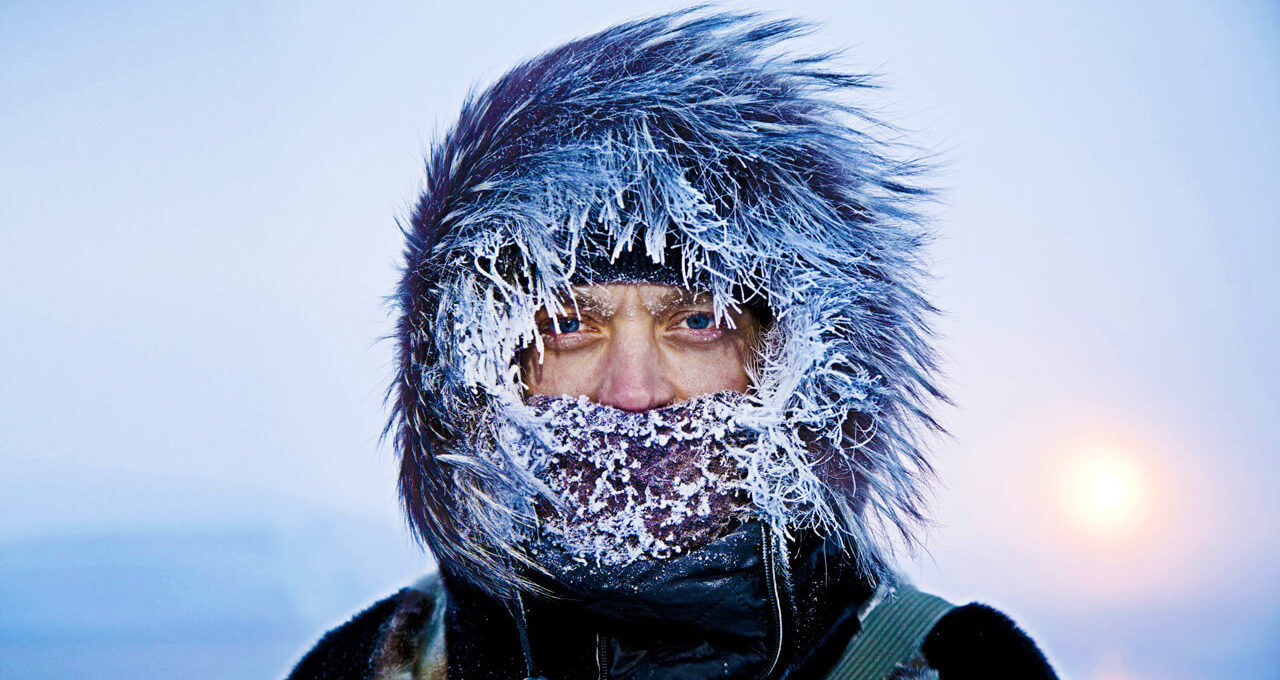












Оставить Комментарий